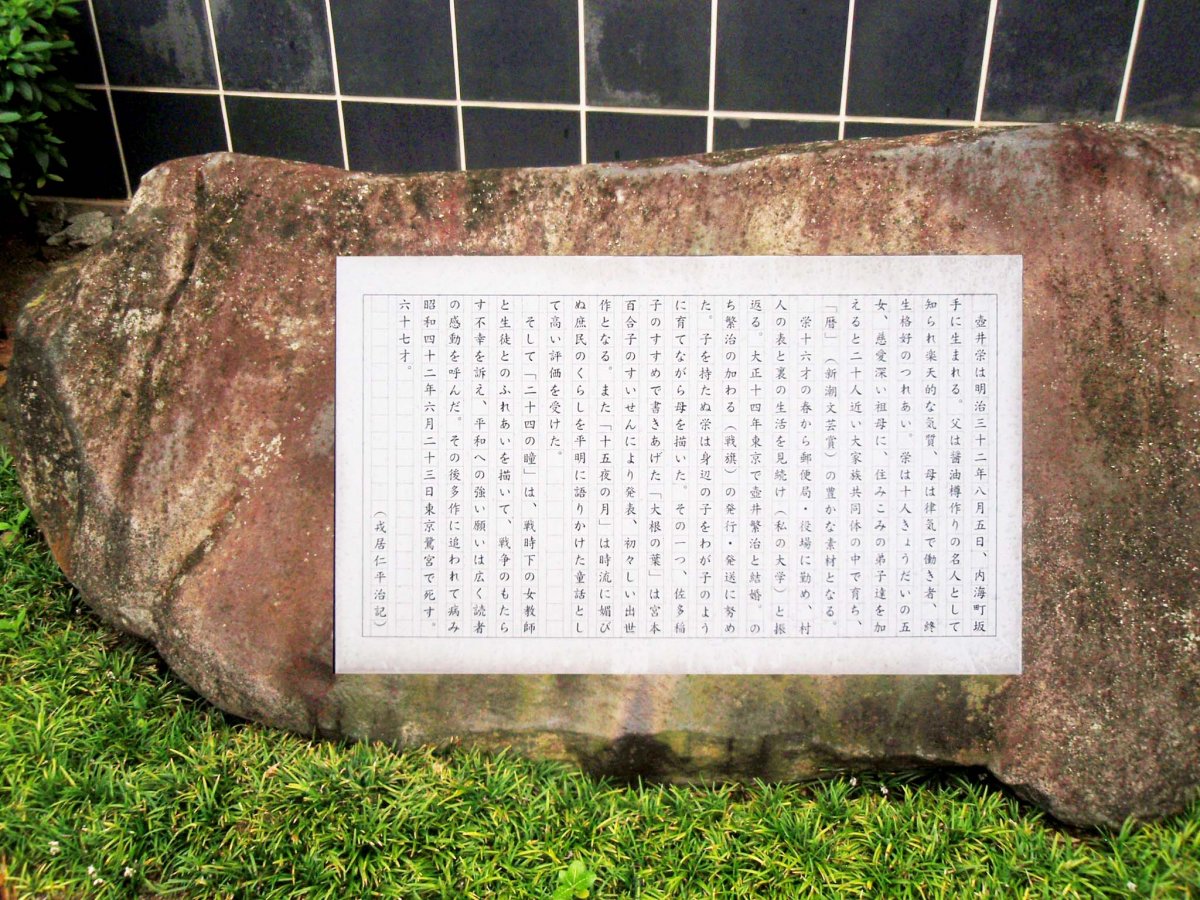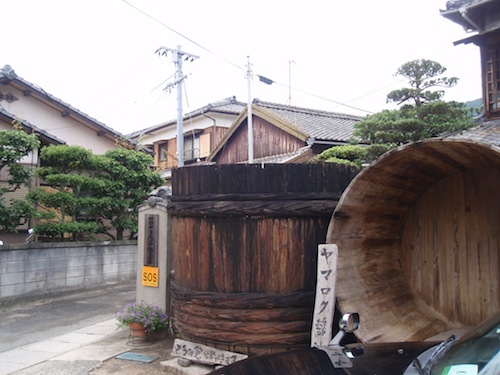Down-to-Earth Japanese
There's something about Old Japan that draws me in again and again. I don't know what it is. When I see old wooden buildings and the earthy ways in which people went about their lives, I feel a nostalgic ache that's almost unbearable. (I feel no such nostalgia for almost anything in my own background.)
The Japanese film Twenty-Four Eyes, which I've written about several times in JOK Notebook entries, also exerts a curious power. I mean, it depicts one harrowing wartime death after another and makes everyone cry, so my reaction isn't remarkable in that sense. But there's something ineffable and incredibly appealing about the story of a teacher on a rural island who gives her all to a group of students in a one-room schoolhouse.
I've tried many times to understand the strong attraction I feel to a life gone by, a life I never experienced, and my thoughts on the matter have been terribly unproductive. But the phrase "down to earth" touches on a key aspect for me. In rural life, there's a premium on survival. Objects that help people do what they need to do become precious. Luxury and artifice have no place on a farm or in a wartime setting. Each stone well, each wooden churn, each copper plate matters. Every item takes on special significance in a stripped-down life. And by seeing those objects, we understand a great deal about people's existences. Their concerns become accessible to us.
I mention this because writing the new essay 1386 on 升 (sho (1.8 liters); small wooden measuring box; square on a grid) made me think of Shodoshima, the setting of Twenty-Four Eyes. Last summer when I went there and visited the village they created as a movie set, I took a picture of a large rock with a bronze plaque embedded in it. The plaque was made to resemble genkoyoshi (原稿用紙, げんこうようし: gridlike paper on which Japanese students write). Because essay 1386 has a bit to do with grids, I included the photo there.

Photo Credit: Eve Kushner
While I was at it, I asked my proofreader what it said. He did a masterful job of typing out the Japanese and translating the sentences. I couldn't let all that hard work go to waste, and the sentences enthralled me, so I included all of them in the essay. They fill three pages of the PDF! I spent quite a bit of time with the sentences, smoothing out the translations and especially breaking down the vocabulary.
The text tells us about the life of Sakae Tsuboi. She grew up on Shodoshima and wrote the novel Twenty-Four Eyes, the basis for the 1954 film. The sentences seem particularly valuable to me because I adore the movie and the island, but I don't think that's the only reason. Written by Tsuboi's nephew with deep affection and an insider's knowledge of his aunt's life, the narrative has an immediacy and accessibility that one rarely sees in a museum plaque. Through the text, the author and her personality come to life. So does the Japanese language. In those sentences I see constructions that I've never encountered before. What a pleasure to know how to say the following things:
Her mother was an honest hard worker.
They were a very good couple until the end of their lives.
She studied the two sides of villagers’ lives.
Sakae brought up children around her as if they were hers.
She depicted mothers in her works.
Sakae made a name for herself with this fresh work.
Her story narrated common people’s lives, unaffected by literary fashions of the times.
She got sick under the pressures of work.
Do you know how to say all that? If not, read on! I'll present just some of the many sentences on the plaque, but all will include the translations you've just read.
1. 父は醤油樽造りの名人として知られ楽天的な気質、母は律儀で働き者、終生格好のつれあい。
Her father was known as a master soy sauce barrel maker with a hopeful nature. Her mother was an honest hard worker. They were a very good couple until the end of their lives.
父 (ちち: father); 醤油 (しょうゆ: soy sauce, where the first kanji is non-Joyo); 樽 (たる: barrel, a non-Joyo kanji); -造り (-づくり: maker); 名人 (めいじん: master); 知る (しる: to know, shown here in its passive form); 楽天的 (らくてんてき: optimistic); 気質 (きしつ: disposition); 母* (はは: mother); 律儀 (りちぎ: honest); 働き者 (はたらきもの: hard worker); 終生 (しゅうせい: all one’s life); 格好 (かっこう: best, perfect); つれあい (連れ合い: spouse)
Here we find 母は律儀で働き者 (mother was an honest hard worker) and 終生格のつれあい (They were a very good couple until the end of their lives). Priceless!
There's also something exciting to me about the earthiness of making barrels, especially for soy sauce. On Shodoshima, where soy sauce making is a specialty, I visited a small soy sauce factory, which was unlike anything I've ever seen before.

Photo Credit: Eve Kushner
2. 栄は十人きょうだいの五女、慈愛深い祖母に、住みこみの弟子達を加えると二十人近い大家族共同体の中で育ち、「暦」(新潮文芸賞)の豊かな素材となる。
Sakae was the fifth eldest daughter of 10 siblings and was brought up in a large family community of almost 20 people, including a fond grandmother and resident (barrel-making) apprentices, which gave her abundant (writing) material for her (book) Koyomi (Calendar), which won the Shinchosha Literature Prize.
栄* (さかえ: female given name); 十人 (じゅうにん: 10 people); きょうだい (兄弟: siblings); 五女 (ごじょ: 5th daughter); 慈愛深い (じあいぶかい: deep affection); 祖母 (そぼ: grandmother); 住みこみ (すみこみ: live-in); 弟子達 (でしたち: apprentices); 加える (くわえる: to include); 二十人 (にじゅうにん: 20 people); 近い (ちかい: near); 大家族 (だいかぞく: extended family); 共同体 (きょうどうたい: community); 中 (なか: in); 育つ (そだつ: to grow up, be brought up); 暦 (こよみ: calendar); 新潮 (しんちょう: magazine and book publisher); 文芸 (ぶんげい: literature); 賞 (しょう: prize); 豊か (ゆたか: abundant); 素材 (そざい: raw material)
This teaches two great words: 大家族 (だいかぞく: extended family) and 素材 (そざい: raw material). The sentence also makes me keen to know more about 暦 (こよみ: calendar), particularly because it includes the "hemp" radical that I've written about in essay 1829 on 麻 (hemp).
Take note of the two highlighted words, as I'll refer to them later.
3. 栄十六才の春から郵便局・役場に勤め、村人の表と裏の生活を見続け(私の大学)と振返る。
In the spring of the year she was 16, Sakae started working at the post office and town hall. There she studied the two sides of villagers’ lives, later recalling that as “my university.”
十六才 (じゅうろくさい: age 16); 春 (はる: spring); 郵便局 (ゆうびんきょく: post office); 役場 (やくば: town hall); 勤める (つとめる: to work (for)); 村人 (むらびと: villager); 表 (おもて: front); 裏 (うら: rear, behind the scenes); 生活 (せいかつ: life); 見続け (みつづける: to gaze at for a long time); 私 (わたし: I); 大学 (だいがく: university); 振返る (ふりかえる: to look back)
What an interesting structure we find in 表と裏! The fronts and backs of people's lives. The artificial facade where everything is presentable versus the behind-the-scenes behavior, which is real, gritty, and often hard to take.
4. のち繁治の加わる(戦旗)の発行・発送に努めた。
Later she became involved in publishing and shipping (the magazine) Senki (Battle Flag) with which Shigeji was involved.
のち (後: afterward); 繁治 (しげじ: her husband's given name); 加わる (くわわる: to participate); 戦旗 (せんき: battle flag); 発行 (はっこう: publishing); 発送 (はっそう: shipping); 努める (つとめる: to make an effort)
Between sentence #2 and sentence #4, we've now seen the transitive and intransitive forms of the following verb:
加える (くわえる: to include), which is transitive, as we saw in the phrase 弟子達を加える (to include apprentices)
加わる (くわわる: to participate), which is intransitive, as we can see above
Also, check out the neat structure of 発行・発送. With a simple raised dot, we can convey "and," as long as we're talking about two thematically related topics.
Finally, look at the verb at the end of the sentence. Although 努める translates as "to make an effort," which sounds forceful and important, it actually carries little weight in the sentence translation.
5. 子を持たぬ栄は身辺の子をわが子のように育てながら母を描いた。
Having no children of her own, Sakae brought up children around her as if they were hers, and she depicted mothers (in her works).
子* (こ: child); 持つ (もつ: to have, shown here in its negative form); 身辺 (しんぺん: around one’s person); わが子 (わがこ: one’s own child); 育てる (そだてる: to bring up); 描く (えがく: to depict)
This powerhouse of a sentence provides two of the translations I mentioned above.
栄は身辺の子をわが子のように育て
Sakae brought up children around her as if they were hers
母を描いた
(She) depicted mothers (in her works)
In sentence #2, we encountered this intransitive word:
育つ (そだつ: to grow up, be brought up)
Sentence #5 gives us the transitive form of the same verb:
育てる (そだてる: to bring up), which appears here in 子を ... 育てる (to bring up children)
6. その一つ、佐多稲子のすすめで書きあげた「大根の葉」は宮本百合子のすいせんにより発表、初々しい出世作となる。
One of them, Daikon no Ha (Radish Leaves), which she finished on the advice of Ineko Sata, was published with the recommendation of Yuriko Miyamoto. Sakae made a name for herself with this fresh work.
一つ (ひとつ: 1); 佐多稲子 (さた いねこ: name of a famous author); すすめ (勧め: advice); 書きあげる (かきあげる: to finish writing); 大根 (だいこん: daikon); 葉 (は: leaf); 宮本百合子 (みやもと ゆりこ: name of a famous novelist); すいせん (推薦: recommendation); 発表 (はっぴょう: publication); 初々しい (ういういしい: fresh); 出世作 (しゅっせさく: literary work that brings fame)
Another translation presents itself:
初々しい出世作となる。
(Sakae) made a name for herself with this fresh work.
Good for her! She deserved it!
7. また「十五夜の月」は時流に媚びぬ庶民のくらしを平明に語りかけた童話として高い評価を受けた。
Her Jugoya no Tsuki (The Harvest Moon) was highly valued as a children’s story that plainly narrated common people’s lives, unaffected by literary fashions of the times.
十五夜 (じゅうごや: night of the full moon, a word used only in autumn); 月 (つき: moon); 時流 (じりゅう: fashions of the times); 媚びる (こびる: to flirt, shown here in its negative form; the kanji is non-Joyo); 庶民 (しょみん: common people); くらし (暮らし: life); 平明 (へいめい: clear; simple); 語る (かたる: to tell); 童話 (どうわ: children’s story); 高い (たかい: high); 評価 (ひょうか: value); 受ける (うける: to receive)
What a great phrase: 時流に媚びぬ (not to "flirt" with the fashions of the times)!
8. その後多作に追われて病み昭和四十二年六月二十三日東京鷺宮で死す。六十七才。
Later she got sick under the pressures of work and passed away in Saginomiya, Tokyo, on June 23, Showa 42 (1967), at the age of 67.
その後 (そのご: after that); 多作 (たさく: productive); 追われる (おわれる: to be pressed); 病む (やむ: to fall ill); 昭和 (しょうわ: name of an era, 1926–1989); 四十二年 (よんじゅうにねん: Year 42); 六月 (ろくがつ: June); 二十三日 (にじゅうさんにち: 23rd of a month); 東京 (とうきょう: Tokyo); 鷺宮 (さぎのみや: place in Tokyo, where the first kanji is non-Joyo); 死す (しす: to die, an archaic term); 六十七才 (ろくじゅうななさい: 67 years old)
Finally, we learn here how to say that someone got sick from working too much. This sentence presents something essentially positive—namely, she was 多作 (たさく: productive). And what's wrong with that? Her productivity "was pressed": 追われる (おわれる: to be pressed). That is, she had to rush to finish work, and pressure bore down on her. This resulted (hence the -て form of 追われて) in sickness (病み, やみ).
I don't want the same thing to happen to you—or to me!—so I'll stop here, leaving you with a preview of the new essay on 升:

Have a great weekend!

Comments